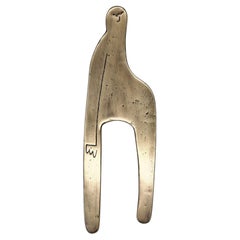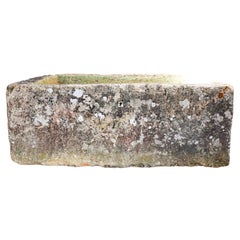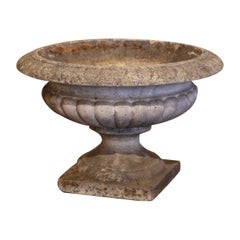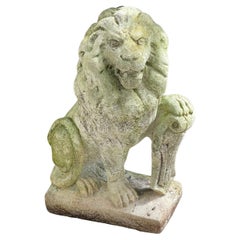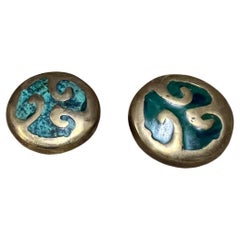Building and Garden Elements
21st Century and Contemporary Moroccan Expressionist Building and Garden Elements
Brass
This 18th-century antique French limestone trough (reference: OT213) is a rare, one-of-a-kind architectural salvage piece sourced from the rural countryside near Clermont-Ferrand, France. Carved by hand between 1760 and 1780, this substantial trough measures 201 cm wide × 130 cm deep × 71 cm high and weighs approximately 3,000 kg. The surface shows an authentic timeworn patina developed over centuries of use, enhancing its historical character.
Material & CraftsmanshipCrafted from solid French limestone (pierre calcaire), this trough was hand-carved from a single block. Its robust composition makes it highly resistant to weathering, while the natural stone’s subtle tonal variations and aged surface bear witness to its centuries-old origin.
Hand carving in the 18th century involved traditional chiseling techniques by skilled stonemasons, leaving subtle tool marks that add to its authenticity and charm.
Possible Uses in Landscape & Garden DesignDue to its size, weight, and historic appeal, this antique stone trough can serve as:
A focal point in a formal or rustic garden design An antique stone planter for trees, shrubs, or seasonal arrangements A water feature basin in a courtyard or landscaped estate A statement piece for heritage property restoration Historical ContextStone troughs of this period were originally used in agricultural settings to hold water or feed for livestock. Their practical role and durable construction have ensured their survival for centuries, making them highly sought after by garden designers, landscape architects, and heritage property owners worldwide.
Why Choose De Opkamer?De Opkamer is a recognised specialist in sourcing authentic European architectural...
18th Century French Other Antique Building and Garden Elements
Limestone
Late 19th Century French Neoclassical Antique Building and Garden Elements
Cast Stone
1940s American American Classical Vintage Building and Garden Elements
Concrete
Mid-19th Century High Victorian Antique Building and Garden Elements
Iron
1950s Mexican Mid-Century Modern Vintage Building and Garden Elements
Malachite, Brass
18th Century English George III Antique Building and Garden Elements
Metal, Enamel
20th Century French Louis XIV Building and Garden Elements
Iron
1970s Belgian Brutalist Vintage Building and Garden Elements
Aluminum
1940s American Vintage Building and Garden Elements
Aluminum, Iron
19th Century American High Victorian Antique Building and Garden Elements
Walnut, Burl
1970s American Brutalist Vintage Building and Garden Elements
Bronze, Copper, Iron
1930s Vintage Building and Garden Elements
Cement
Early 19th Century Italian Empire Antique Building and Garden Elements
Marble
19th Century French Rococo Antique Building and Garden Elements
Wood
1890s Belgian Antique Building and Garden Elements
Metal
19th Century French Gothic Revival Antique Building and Garden Elements
Bronze, Wrought Iron
Mid-20th Century Italian Rustic Building and Garden Elements
Clay, Terracotta
Early 20th Century French Neoclassical Building and Garden Elements
Wood, Pine
1950s American American Colonial Vintage Building and Garden Elements
Metal
19th Century Dutch Georgian Antique Building and Garden Elements
Mahogany
1980s Italian Art Nouveau Vintage Building and Garden Elements
Bronze
2010s Italian Building and Garden Elements
Steel
16th Century Austrian Renaissance Antique Building and Garden Elements
Wrought Iron
19th Century French Napoleon III Antique Building and Garden Elements
Bronze, Zinc
19th Century Italian Antique Building and Garden Elements
Marble
2010s Belgian Post-Modern Building and Garden Elements
Clay
19th Century English Antique Building and Garden Elements
Metal
Early 20th Century European Bauhaus Building and Garden Elements
Brass
Mid-20th Century European Building and Garden Elements
Porcelain
19th Century French Antique Building and Garden Elements
Iron
Late 19th Century European Art Nouveau Antique Building and Garden Elements
Iron
19th Century French Louis XV Antique Building and Garden Elements
Marble
Late 20th Century Building and Garden Elements
Marble
20th Century English Georgian Building and Garden Elements
Pine
Late 19th Century French Louis XV Antique Building and Garden Elements
Marble
Late 20th Century Indonesian Other Building and Garden Elements
Teak
Early 20th Century Victorian Building and Garden Elements
Stained Glass, Hardwood
18th Century French Louis XV Antique Building and Garden Elements
Wood
21st Century and Contemporary Philippine Art Deco Building and Garden Elements
Brass
Early 20th Century American American Classical Building and Garden Elements
Brass, Wire
1920s American Arts and Crafts Vintage Building and Garden Elements
Iron
Mid-19th Century French Louis XV Antique Building and Garden Elements
Wood
19th Century English Victorian Antique Building and Garden Elements
Metal, Iron
21st Century and Contemporary Italian Classical Greek Building and Garden Elements
Marble
20th Century English Other Building and Garden Elements
Stone, Metal
19th Century French Louis XVI Antique Building and Garden Elements
Marble, Breccia Marble
20th Century Chinese Qing Building and Garden Elements
Bronze
21st Century and Contemporary European Building and Garden Elements
Wicker
19th Century Italian Neoclassical Antique Building and Garden Elements
Ormolu
Mid-20th Century American Mid-Century Modern Building and Garden Elements
Iron
19th Century Antique Building and Garden Elements
Fabric, Wood
Mid-20th Century Chinese Chinese Export Building and Garden Elements
Porcelain
1960s American Mid-Century Modern Vintage Building and Garden Elements
Cut Steel, Iron
Early 20th Century English Gothic Building and Garden Elements
Wood, Oak
1920s Italian Vintage Building and Garden Elements
Stone
Mid-19th Century Antique Building and Garden Elements
Oak
1970s American Brutalist Vintage Building and Garden Elements
Late 19th Century French Antique Building and Garden Elements
Brass
Late 18th Century French Louis XV Antique Building and Garden Elements
Griotte Marble
Antique Garden Furniture and Architectural Elements
Choosing the right antique or vintage building and garden elements can prove pivotal when you’re working to beautify any room in your home or just put the finishing touches on a garden or other outdoor area.
It takes time and effort to improve your outdoor space or merely to bring an air of tranquility to an indoor area set aside for private relaxation or gathering with friends. The good news is that 1stDibs can help.
To introduce a sense of timelessness to a back patio or interior common area, choose cast-stone statues or sculptural busts for a dose of drama or select ornate architectural elements such as corbels, plaques or panels made of marble or iron. Elsewhere, find a focal point in your living room and create a “feature wall” by bringing pops of color into a corner with handmade antique ceramic tiles.
It helps when design changes like these have a practical upside too.
Victorian cast-iron stair treads hearken back to a time when adding decorative details to your property was a priority. While lending an attractive appearance to an exterior staircase, these safeguards render the steps slip-resistant for those coming and going. And as one good stylistic choice usually leads to another, pairing your sophisticated treads with a coupling of 19th-century hand-forged andirons would be a thoughtful, durable touch for any courtyard or comfortable lounge space, be they intended for an indoor fireplace or a patio firepit.
Where the garden is concerned, any sophisticated garden ornaments you select should work with nature, not against it. Wrought-iron garden gates will simply refuse to be relegated to the background. Instead, they’ll draw attention to your painstakingly sculpted hedges and colorful flora. When paired with a sparse arrangement of other tasteful additions, such as a stone planter, garden stool or other welcoming pieces of outdoor seating, the effect can be transformative.
On 1stDibs, find a sprawling collection of antique garden furniture and architectural elements that meet every need. Our offerings include everything from sculptural bathroom fixtures to flooring ideas to pedestals and columns designed in a variety of styles and much more.
Read More
39 Incredible Swimming Pools
It's hard to resist the allure of a beautiful pool. So, go ahead and daydream about whiling away your summer in paradise.
This Lavish 18th-Century Chimneypiece Comes from a Historic Scottish Estate
The exceptionally crafted mantel was saved despite the home’s regrettable demise.
A Pair of Monumental Stone Tigers Protect and Guide Wandering Souls
The Qing dynasty beasts honored the dead and warned off malicious spirits.
Andrés Monnier’s Stone Tub Makes Bathing a Rite of Renewal
The dramatic piece transforms a daily scrub into an act of communion with the elements.
Meet the Siblings behind the Exquisite Outdoor Furniture of McKinnon and Harris
Anne and Will Massie apply the lessons of the past to create alfresco pieces as timeless as the traditions that inspire them.
35 Wondrous Outdoor Dining Spaces
Eating meals alfresco is one of the great pleasures of warm weather, and a beautifully appointed space only heightens the experience. Get inspired by these delectable dining areas as you think about creating your own outdoor oasis.
In These Chic Homes, Indoors and Outdoors Freely Mingle
Through potted plants, garden furniture, nature-inspired art and architectural apertures, designers are bringing the outside in.
24 Perfect Patios with Fire Pits and Fireplaces
In these stylish spaces, the outdoor season extends year round.
